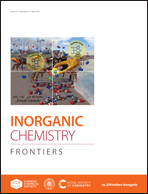A new honeycomb metal–carboxylate-tetrazolate framework with multiple functions for CO2 conversion and selective capture of C2H2, CO2 and benzene†
Abstract
The reaction of 2,5-di(2H-Tetrazol-5-yl)terephthalic acid (H4dtztp) and Cd2+ ions afforded a new three-dimensional (3D) honeycomb framework, [Me2NH2][Cd(dtztp)0.5(HCOO)]·1.5DMF·H2O (1). 1 contains a unique type of metal–carboxylate–azolate chain SBU and forms hexagonal tubular channels, as well as revealing high adsorption capacity for CO2 and C2H2, and significantly selective separation of CO2/CH4, C2H2/CO2 and C2H2/CH4. Molecular simulations were performed to study the interactions between the framework and gas molecules. Importantly, 1 shows good thermal stabilities (300 °C), mechanical stabilities and chemical stabilities in acidic (pH = 2) and basic (pH = 12) aqueous solutions. Meanwhile, the MOF as a heterogeneous catalyst can efficiently catalyze the cyclic addition reaction between CO2 and different epoxides to produce cyclic carbonates with high conversion yields. In addition, the selective adsorption of the MOF for benzene over cyclohexane was also studied.



 Please wait while we load your content...
Please wait while we load your content...